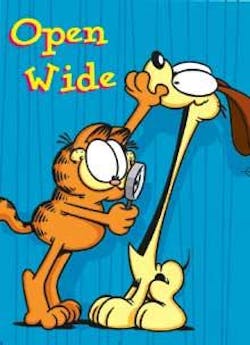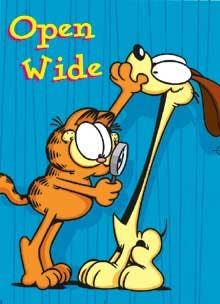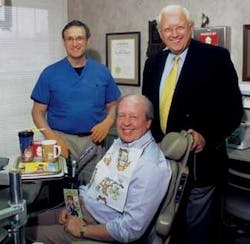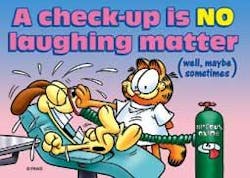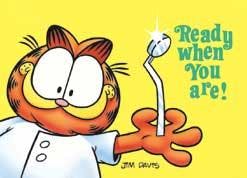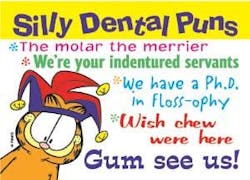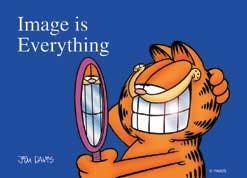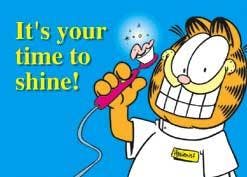Garfield — The Ambassador of Comic Goodwill
by Curt Hamann, MD, Pamela Rodgers, PhD, and Naomi Rhode, RDH
It's been an amazing 25 years. During that time, we've watched him grow into a megastar of print, celluloid and now digital media. Of course, we're referring to Garfield, the cantankerous crabby cat with a scaler-sharp wit. He loves to sleep in, avoid Mondays, and eat. Did we mention eating? Between his passion for lasagna and aversion to work, Garfield has made a double-decade career of earnestly chugging coffee, mauling the mailman, and harassing the dog.
The man behind this meowing myth is Jim Davis, cartoonist extraordinaire. Starting out in the 1970s as a cartoon strip assistant, Jim created his first comic strip based on insects.1 Fortunately for all of us, a crafty cat began to surface shortly thereafter. Thus, the legendary fur ball known as Garfield was born. In 1981, Jim formed Paws, Inc., a creative business enterprise to support Garfield's expanding stardom (and waistline).
Garfield, of course, has had his paw in dentistry since that first year, with several comic strips devoted to teeth and dentistry. Early in Garfield's career, many dental hygienists adopted him as their favorite character for communicating with patients through appointment, recall, and reactivation cards. We've estimated that nearly 7 percent of dental patients in the United States have received a Garfield card at least once in the last 20 years.
What makes Garfield so good as an ambassador of comic goodwill? Jim makes a concerted effort to focus on universal human themes that we can all relate to, such as sleeping or eating. And of course, Garfield is always interested in his own comforts — a very human trait. Although Jim is grounded in Indiana farm-boy roots, Garfield is considered a crafty city cat. When paired with Garfield's wisecracking personality, it's hard for him not to be funny. We asked the orange tabby how he felt about being recognized as an ambassador of comic goodwill, and his response was typical Garfield: "Well, duh!"
Garfield naps in the dental chair
Dental practices have ordered a staggering 180 million Garfield cards since 1980. In a very real way, Garfield has likely kept patients coming back to you for oral hygiene visits. What started with a few posters and cards has grown to nearly 2,000 products in the SmartPractice catalog alone, ranging from dental bibs to toothbrushes. The most recent addition to the amazing variety of Garfield dental products is medical grade examination gloves in vivid tabby tangerine.
Now that his 26th birthday is here, we barely remember the original Garfield — no stripes, large ears, but still chunky — and appearing in only 40 newspapers.1 Today, Garfield is a published comedic megastar syndicated in newspapers from 111 countries and 130 million books. In addition to his dental product repertoire, he is found on literally thousands of consumer goods including clothes, license plates, food, jewelry, pet products, housewares and office supplies, to name just a few.
It's obvious that many dental hygienists already view Garfield as an ambassador of comic goodwill. A few hygienists are avid collectors. Others, realizing patients can be anxious and stressed when visiting the dentist, like the effect created by a cartoon presence in dealing with their patients. According to annual cartoon celebrity scoring by Marketing Evaluations, Inc., Garfield is ranked in the top 10 percent of cartoon favorites by both adults and children. Garfield is familiar to patients of all age groups — in other words, a recognized celebrity.
Occasionally, dental professionals may feel uncomfortable using cartoon humor in dental practice settings. Some individuals may feel this approach is "unprofessional" in what should be a serious environment. Certainly humor should never be used to ridicule or control individuals, or to overstep the boundaries of propriety and sensitivity. Like any tool applied in patient care, cartoons should be used wisely and appropriately. But as Jim Davis notes, "There are so many wonderful, effective uses of cartoons to visually inform and educate — and at the same time relax the patient. So why not use it?"
Garfield demystifies patient care with humor
Jim Davis and Garfield are obvious experts in humor. We recently had the opportunity to ask Jim (at his dentist's office) to advise dental hygienists on the use of humor in dentistry. His comment — given from a dental patient's point of view — was quite instructive: "Keeping relationships with the patient — and the entire ambience of the experience — is important. Demystify what is happening in the office with a certain amount of humor."
Humor is known as an amazing mediator.2,3 Horace Walpole, an English novelist, once wrote: "Imagination was given to man to compensate him for what he isn't. A sense of humor was provided to console him for what he is."3 Jokes, funny stories, and even humorous products can put people at ease in a way that normal conversation cannot. We all have used humor in different social situations to "break the ice," — reduce tension, break down barriers and create bonds between people.
Humor and laughter can improve communication and give us the ability to have a different perspective on events.3 Or, as Victor Borge, musical comedian, once quipped, "Laughter is the shortest distance between two people." What does this mean to dental hygiene patients? Oddly enough, it often brings a sense of control. Humor can empower a fearful patient so that they feel in control of the situation. This is a valuable strategy that dental hygienists can employ. Certainly your patients love the results of optimum oral hygiene but may avoid dental care because of their fears.
Humor can also be used to target health messages more effectively to patients. For example, a typical American cigarette warning label states: "Smoking causes lung cancer, heart disease, emphysema, and may complicate pregnancy." Some communication experts have suggested modifying the labels to: "Long-term smoking means that you will probably need assistance from friends or family to bathe, use the bathroom, eat, prepare food, and take care of your most basic needs." For aging baby-boomers who are often concerned with maintaining their independent lifestyle, this message may produce a chuckle and motivate a change of habit.
Laughter really is the best medicine
Nearly all of us are subjected to some form of stress during our daily lives. Stress is the antithesis of humor, and is well known for its adverse effects on blood pressure, muscle tension, and suppressing the immune system.4 So it should not be surprising that laughter should have an equal but opposite effect.
Intuitively, we all know how much better we feel when we laugh. Fortunately, modern medicine is now beginning to understand the complex and beneficial physiological changes that occur with laughing. Perceiving something as funny creates changes in our brain and nervous system that are transmitted to the rest of our body.4 Our blood flow improves, muscle activity increases or relaxes, and endorphins are produced.
Laughter also activates certain components of our immune system that are known to fight off disease such as natural killer cells and saliva-based immunoglobulins.5,6 Therefore, one of our first mechanisms of "defense against the universe" — as Mel Brooks has said — really might be laughter. And the dental chair might be a very healthy place to activate it!
Finding time to laugh is not always easy. Frequently, we are too involved in our day-to-day difficulties, or overburdened with what seems like an impossible schedule and demands on our time. But exercising our funny bone can be a great way to cope with this stress. Encouraging laughter during a hygiene visit can help patients relax and feel more comfortable. In this role, Garfield is indispensable ... and deserving of his ambassadorship.
So how can you be funny when you're struggling to scale years of dental calculus or dealing with a difficult patient? Find a delightful story to tell — maybe even a tidbit or quip about Garfield. Let colorful bibs, toothbrushes, gloves, or other supplies create an atmosphere of fun. Exchange jokes with office staff ... appropriate gags only, of course. Use funny reminder, recall, and reactivation cards to communicate with your patients.
Yes, dentistry really has a funny bone
Just for the record, comedy and dentistry have long been partners. Famous writers such as Mark Twain have often quipped about dentists in their writings. There are countless examples of cinematic comedy involving dentistry, such as one of Hollywood's earliest films, Charlie Chaplin's 1914 film Laughing Gas.7 Both Laurel and Hardy and the Three Stooges made multiple films based on funny dental themes during the early 20th century.
A few dental professionals may take a dim view of this humor, which was often unkind, and based partly on the somewhat shady reputation of dentistry prior to the turn of the 20th century. However, today's patients (and their dental hygienists) are far more sophisticated and knowledgeable. Both expect quality oral care to be delivered. Today's patient will relate to the use of humor in oral health care just as well as they would in any other professional setting.
Historically, dental comedy was not limited to live action; cartoons and dentistry have frequently teamed up, often for educational purposes. One of the most famous included an upstart filmmaker in Kansas City, whose studio survived by creating a children's film on dental health for a local dentist.7 The 1922 film included both animated and live action sequences. The visionary young filmmaker was Walt Disney. Disney went on to make many other educational films, including some about dentistry. Jim Davis and Garfield have followed in this Disney tradition, making educational books and videos to encourage reading and learning.
The frisky feline helps you partner with patients
Science increasingly links oral hygiene and overall health, putting dental professionals on the front line of health promotion. Research shows that humor and laughter can foster positive attitudes that increase patient satisfaction as well as promote overall health.8 Partnering with patients gives dental hygienists the opportunity to communicate a message of feeling good and looking good.9 Since humor and laughter can create trust and a sense of partnership with your patient, why not scratch your funny bone?
Using personalized cards, posters, toothbrushes, tote bags, and other dental office paraphernalia — with Garfield or other fun imagery — can create an environment that is friendly, humorous, and non-threatening. Patients are then more likely to confide their expectations (and fears) in you. Let your patients see you as an ally and as an advocate for their optimal dental care.
This light-hearted environment yields multiple benefits. First, it will create a more enjoyable place for you to work.9,10 More importantly, your positive attitude will infect your patients — bringing them back again and again. With this approach, hygienists listen more, helping patients realize their best care. At this level of communication, you'll have an even greater impact on patient care and their long-term health.
Laughter won't take the place of quality oral hygiene, but it certainly can augment it. And Garfield's pesky personality is purrfect for the task! Beneath the orange tabby exterior, Garfield's human persona makes him likeable and funny. Remember ... he usually does things we'd love to do if we could get away with it. It's that human character that helps educate, diminish fears, and make people laugh. So serve up the lasagna — here comes Garfield, your dental spokes-cat for comic goodwill!
The Crazy Cat Chats:An interview with Garfield
Authors: Garfield, at 25, you've achieved worldwide celebrity status and have had a tremendous impact on dentistry. How has becoming a superstar changed your life?
Garfield: It hasn't. I'm still the same sweet so-and-so I've always been.
Authors: Now that you're hitting the big screen, isn't it hard to keep up that lazy couch potato image?
Garfield: Nah. I can schmooze between catnaps.
Authors: Since you are an established and "mature" movie and television star, it's even more important to take care of that terrific smile. So, do you visit your dentist regularly?
Garfield: YES. You can't overestimate the importance of good dental hygiene. (One more time, how much am I being paid to say that?)
Authors: Are you planning on having any cosmetic work done to stave off the effects of aging?
Garfield: Don't ever mess with perfection. Besides, cats don't age. We mellow.
Authors: What do you remember about your first dental visit?
Garfield: Scratching ... and spit... and that was just on the way to the office.
Authors: What's your favorite flavor of prophy paste? Tuna, pizza or lasagna?
Garfield: I'll have to go with the lasagna paste. It makes a great dip, too.
Authors: What would you say to some people who might think dentistry isn't funny?
Garfield: Hellooooo ... laughing gas.
Garfield's Rise to Stardom** The cantankerous, chubby tabby was first introduced to the world (without stripes) on June 19, 1978.
* After spending his early childhood in an Italian restaurant, Garfield's favorite food has become lasagna.
* Garfield's first book hit No. 1 on the New York Times Bestsellers List in 1980, only two years after his debut in the funny pages.
* Of course, Garfield's passion for sleeping and eating can impact his image. But he doesn't worry; when challenged with dieting he notes, "I'm not overweight, just undertall."
* Garfield became an icon of popular culture in the 1980s with the creation of suction-cup Garfields. These plush crazy kitties evoked such hysteria that they were the subjects of cat-nabbings, as well as appearances on late night television and in the movies.
* Some of the more unusual products graced with Garfield's grin include a toilet seat cover, Japanese pachinko machine, hot air balloon, and chopsticks (imagine having to squeeze the fat cat on a skinny chopstick!).
* Garfield's latest endeavor is a full-screen live-action film titled ... what else? ... Garfield. Bill Murray delivers the definitive edge to the computer-generated fat cat, filling the screen with catty-isms.
* For an amazing and entertaining history of Garfield, read "Garfield at 25: In Dog Years I'd Be Dead."
Curt Hamann, MD, Pamela Rodgers, PhD, and Naomi Rhode, RDH, are affiliated with SmartPractice, which is based in Phoenix. Dr. Hamann can be contacted at hamann@ smarthealth.com
Acknowledgements: The authors gratefully acknowledge the assistance of Karen Baillie and Kim Sullivan of SmartPractice, as well as that of Jim Davis, Kim Campbell and Kassie Adams of Paws, Inc. (and, of course, Garfield).
References1. Davis J. Garfield At 25: In Dog Years I'd Be Dead.1-221, 2004.
2. Rakel RE. Compassion and the art of family medicine: from Osler to Oprah. J Am Board Fam Pract 13:440-448, 2000.
3. Bennett HJ. Humor in medicine. South Med J 96:1257-1261, 2003.
4. Calman K. A study of storytelling, humour and learning in medicine. Clin Med 1:227-229, 2001.
5. Takahashi K, Iwasi M, Yamashita K, Tatsumoto Y, Ue H, Kuratsune H, Shimizu A, Takeda, M. The elevation of natural killer cell activity induced by laughter in a crossover designed study. Int J Mol Med 8:645-650, 2001.
6. Hucklebridge F, Lambert S, Clow A, Warburton DM, Evans PD, Sherwood N. Modulation of secretory immunoglobulin A in saliva; response to manipulation of mood. Biol Psychol 53:25-35, 2000.
7. Wynbrandt J. The Million Dollar Smile. 217-234, 1998.
8. Little P, Everitt H, Williamson I, Warner G, Moore M, Gould C, Ferrier K, Payne S. Observational study of effect of patient centredness and positive approach on outcomes of general practice consultations. BMJ 323:908-911, 2001.
9. Blatchford WA. Creating value: partner with your patient. J Calif Dent Assoc 28:373-7, 379, 2000.
10. Gluch J. Opportunities to educate patients during dental hygiene care. Contemporary Oral Hygiene 4:16-19, 2004.
